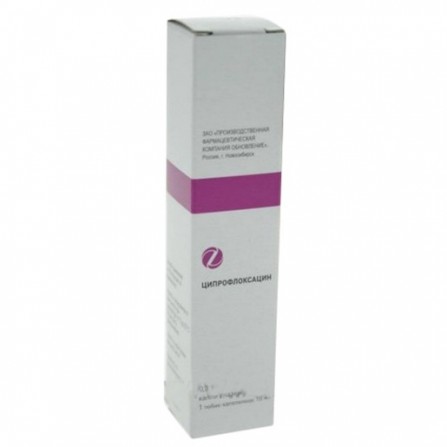Ciprofloxacin eye drops 0.3% 10ml
Condition: New product
996 Items
Rating:
Be the first to write a review!

More info
Active ingredients
Ciprofloxacin
Composition
Ophthalmic ointment 0.3% 1 ml ciprofloxacin (in the form of monohydrate hydrochloride) 3 mg.
Pharmacological effect
Antimicrobial agent of broad-spectrum fluoroquinolone group. It has a bactericidal effect. Suppresses DNA gyrase and inhibits the synthesis of bacterial DNA. Highly active against most gram-negative bacteria: Pseudomonas aeruginosa, Haemophilus influenzae, Escherichia coli, Shigella spp., Salmonella spp., Neisseria meningitidis, Neisseria gonorrhoeae. Active against Staphylococcus spp. (including strains that produce and do not produce penicillinase, methicillin-resistant strains), some strains of Enterococcus spp., Campylobacter spp., Legionella spp., Mycoplasma spp., Chlamydia spp., Mycobacterium spp. Ciprofloxacin is active against β-lactamase producing bacteria. To ciprofloxacin resistant Ureaplasma urealyticum, Clostridium difficile, Nocardia asteroides. The effect on Treponema pallidum is not well understood.
Pharmacokinetics
Rapidly absorbed from the digestive tract. Bioavailability after oral administration is 70%. Eating a little effect on the absorption of ciprofloxacin. Plasma protein binding is 20-40%. Distributed in tissues and body fluids. Penetrates into the cerebrospinal fluid: the concentration of ciprofloxacin with noninflammatory cerebral membranes reach 10%, with inflamed up to 37%. High concentrations are reached in bile. Excreted in urine and bile.
Indications
Infectious and inflammatory diseases caused by microorganisms susceptible to ciprofloxacin, including diseases of the respiratory tract, abdominal cavity and pelvic organs, bones, joints, skin, septicemia, severe infections of upper respiratory tract. Treatment of postoperative infections. Prevention and treatment of infections in patients with reduced immunity. For topical use: acute and subacute conjunctivitis, blepharoconjunctivitis, blepharitis, bacterial ulcers of the cornea, keratitis, keratoconjunctivitis, chronic dacryocystitis, meybomites. Infectious eye damage after injury or foreign bodies. Preoperative prophylaxis in ophthalmosurgery.
Contraindications
Pregnancy, lactation (breastfeeding), children and adolescents under 18 years old, hypersensitivity to ciprofloxacin and other quinolone preparations.
Use during pregnancy and lactation
Contraindicated in pregnancy, during lactation. Ciprofloxacin penetrates the placental barrier, excreted in breast milk. In experimental studies found that it causes arthropathy.
Dosage and administration
Individual. Inside - 250-750 mg 2 times / day. The duration of treatment is from 7-10 days to 4 weeks. For the on / in the introduction of a single dose - 200-400 mg, the frequency of administration - 2 times / day; the duration of treatment is 1-2 weeks, if necessary, and more. You can enter in / in the jet, but more preferably drip introduction within 30 minutes. When applied topically, 1-2 drops are instilled into the lower conjunctival sac of the affected eye every 1-4 hours. After improving the condition, the intervals between instillations can be increased. The maximum daily intake for adults when administered orally is 1.5 g.
Side effects
On the part of the digestive system: nausea, vomiting, diarrhea, abdominal pain, increased activity of hepatic transaminases, alkaline phosphatase, LDH, bilirubin, pseudomembranous colitis. From the side of the central nervous system: headache, dizziness, fatigue, sleep disorders, nightmares, hallucinations, fainting, visual disturbances. From the urinary system: crystalluria, glomerulonephritis, dysuria, polyuria, albuminuria, hematuria, a transient increase in serum creatinine. From the side of the hemopoietic system: eosinophilia, leukopenia, neutropenia, change in the number of platelets. Co-side of the cardiovascular system: tachycardia, cardiac arrhythmias, arterial hypotension. Allergic reactions: pruritus, urticaria, angioedema, Stevens-Johnson syndrome, arthralgia. Adverse reactions associated with chemotherapeutic action: candidiasis. Local reactions: pain, phlebitis (with a / in the introduction). When using eye drops in some cases, there may be mild soreness and hyperemia of the conjunctiva. Other: vasculitis.
Interaction with other drugs
With the simultaneous use of ciprofloxacin with didanosine, the absorption of ciprofloxacin is reduced due to the formation of complexones of ciprofloxacin with aluminum and magnesium buffers contained in didanosine. With simultaneous use with warfarin increases the risk of bleeding. With simultaneous use of ciprofloxacin and theophylline, it is possible to increase the concentration of theophylline in the blood plasma, increase the T1 / 2 of theophylline, which leads to an increase in the risk of toxic effect associated with theophylline.Simultaneous administration of antacids, as well as preparations containing ions of aluminum, zinc, iron, or magnesium, may cause a decrease in the absorption of ciprofloxacin, therefore the interval between administration of these drugs must be at least 4 hours.
special instructions
In patients with impaired renal function, correction of the dosage regimen is required. With caution used in elderly patients, with atherosclerosis of cerebral vessels, disorders of cerebral circulation, epilepsy, convulsive syndrome of unknown etiology. During treatment, patients should receive an adequate amount of fluid. In case of persistent diarrhea, ciprofloxacin should be discontinued. With simultaneous intravenous injection of ciprofloxacin and barbiturates, control of heart rate, blood pressure, ECG is necessary. In the course of treatment, it is necessary to control the concentration of urea, creatinine, and hepatic transaminases in the blood. During the treatment period, a decrease in reactivity is possible (especially when used simultaneously with alcohol). The introduction of ciprofloxacin subconjunctivally or directly into the anterior chamber of the eye is not allowed.


